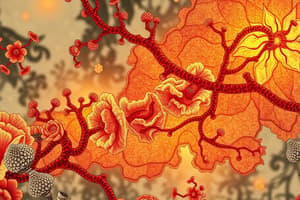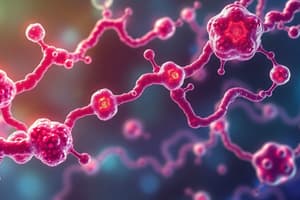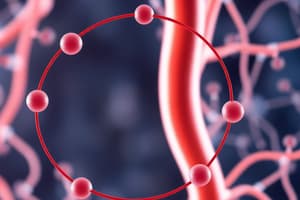Podcast
Questions and Answers
What is the primary function of pyruvate dehydrogenase complex (PDH complex) in cellular respiration?
What is the primary function of pyruvate dehydrogenase complex (PDH complex) in cellular respiration?
- To produce lactic acid from NADH
- To phosphorylate glucose derivatives
- To convert pyruvate into glucose
- To convert pyruvate into acetyl-CoA (correct)
What cofactor does enzyme 1 of the PDH complex utilize?
What cofactor does enzyme 1 of the PDH complex utilize?
- Thiamine pyrophosphate (TPP) (correct)
- Nicotinamide adenine dinucleotide (NAD+)
- Lipoic acid
- Flavin adenine dinucleotide (FAD)
Which of the following substances stimulates pyruvate dehydrogenase kinase (PDK), inhibiting the PDH complex?
Which of the following substances stimulates pyruvate dehydrogenase kinase (PDK), inhibiting the PDH complex?
- ADP
- Pyruvate
- NADH (correct)
- Calcium
What is the product formed when NADH reduces pyruvate in the absence of oxygen?
What is the product formed when NADH reduces pyruvate in the absence of oxygen?
How does insulin affect the activity of the PDH complex?
How does insulin affect the activity of the PDH complex?
What occurs during step 1 of the PDH complex reaction?
What occurs during step 1 of the PDH complex reaction?
What consequence can result from a thiamine deficiency?
What consequence can result from a thiamine deficiency?
Which enzyme in the PDH complex contains FAD as a cofactor?
Which enzyme in the PDH complex contains FAD as a cofactor?
What effect does high ATP levels have on PDH complex activity?
What effect does high ATP levels have on PDH complex activity?
What dietary habit is associated with thiamine deficiency and may lead to beriberi?
What dietary habit is associated with thiamine deficiency and may lead to beriberi?
What are the outputs of the Pyruvate Dehydrogenase Complex reaction?
What are the outputs of the Pyruvate Dehydrogenase Complex reaction?
Which compound is generated first when Coenzyme A reacts with the acetyl group?
Which compound is generated first when Coenzyme A reacts with the acetyl group?
Which of the following inhibits the Pyruvate Dehydrogenase Complex?
Which of the following inhibits the Pyruvate Dehydrogenase Complex?
What role does FAD play in the Pyruvate Dehydrogenase Complex?
What role does FAD play in the Pyruvate Dehydrogenase Complex?
Which enzyme in the Pyruvate Dehydrogenase Complex is responsible for removing CO2?
Which enzyme in the Pyruvate Dehydrogenase Complex is responsible for removing CO2?
Which symptom is associated with Wernicke-Korsakoff Syndrome?
Which symptom is associated with Wernicke-Korsakoff Syndrome?
Which of the following is NOT a condition caused by thiamine deficiency?
Which of the following is NOT a condition caused by thiamine deficiency?
Which factors stimulate the activity of the Pyruvate Dehydrogenase Complex?
Which factors stimulate the activity of the Pyruvate Dehydrogenase Complex?
What is the main consequence of a deficiency in thiamine?
What is the main consequence of a deficiency in thiamine?
How does NAD+ interact in the reaction sequence involving FADH2?
How does NAD+ interact in the reaction sequence involving FADH2?
Flashcards
Pyruvate Dehydrogenase Complex (PDC)
Pyruvate Dehydrogenase Complex (PDC)
An enzyme complex that converts pyruvate into acetyl-CoA, generating carbon dioxide (CO2) and NADH as byproducts.
PDC Function
PDC Function
Converts pyruvate into acetyl-CoA, which is then used in the citric acid cycle for energy production.
PDC Inputs
PDC Inputs
Pyruvate, TPP, Lipoic acid, Coenzyme A, FAD, NAD+
PDC Outputs
PDC Outputs
Signup and view all the flashcards
PDC Inhibition
PDC Inhibition
Signup and view all the flashcards
PDC Stimulation
PDC Stimulation
Signup and view all the flashcards
Pyruvate Dehydrogenase (E1)
Pyruvate Dehydrogenase (E1)
Signup and view all the flashcards
Dihydrolipoamide Acetyltransferase (E2)
Dihydrolipoamide Acetyltransferase (E2)
Signup and view all the flashcards
Dihydrolipoamide Dehydrogenase (E3)
Dihydrolipoamide Dehydrogenase (E3)
Signup and view all the flashcards
Confabulation
Confabulation
Signup and view all the flashcards
What is pyruvate?
What is pyruvate?
Signup and view all the flashcards
What happens to pyruvate in the presence of oxygen?
What happens to pyruvate in the presence of oxygen?
Signup and view all the flashcards
What is the pyruvate dehydrogenase complex?
What is the pyruvate dehydrogenase complex?
Signup and view all the flashcards
What are the cofactors of the pyruvate dehydrogenase complex?
What are the cofactors of the pyruvate dehydrogenase complex?
Signup and view all the flashcards
How is the activity of the pyruvate dehydrogenase complex regulated?
How is the activity of the pyruvate dehydrogenase complex regulated?
Signup and view all the flashcards
What factors stimulate PDK, inhibiting the PDH complex?
What factors stimulate PDK, inhibiting the PDH complex?
Signup and view all the flashcards
What factors inhibit PDK, activating the PDH complex?
What factors inhibit PDK, activating the PDH complex?
Signup and view all the flashcards
How does insulin influence the PDH complex?
How does insulin influence the PDH complex?
Signup and view all the flashcards
What is Beriberi?
What is Beriberi?
Signup and view all the flashcards
How can alcoholism contribute to Beriberi?
How can alcoholism contribute to Beriberi?
Signup and view all the flashcards
Study Notes
Transition Stage of Cellular Respiration
- Pyruvate, a 3-carbon molecule, is the end product of glycolysis.
- Two pyruvate molecules are generated from one glucose molecule.
- Pyruvate enters the mitochondria and is converted to acetyl-CoA in the presence of oxygen.
- NADH from glycolysis carries electrons to the electron transport chain in the presence of oxygen.
- In the absence of oxygen, NADH reduces pyruvate to lactic acid.
Pyruvate Dehydrogenase Complex
- Pyruvate dehydrogenase complex (PDH complex) consists of 3 enzymes:
- Enzyme 1 (Pyruvate dehydrogenase): contains thiamine pyrophosphate (TPP) as a cofactor.
- Enzyme 2 (Dihydrolipoamide acetyltransferase): contains lipoic acid with disulfide bonds.
- Enzyme 3 (Dihydrolipoamide dehydrogenase): contains FAD and NAD+.
Regulation of the Pyruvate Dehydrogenase Complex
- PDH complex activity is tightly regulated via phosphorylation and dephosphorylation.
- Pyruvate dehydrogenase kinase (PDK) phosphorylates enzyme 1, inhibiting PDH complex activity.
- Pyruvate dehydrogenase phosphatase (PDP) dephosphorylates enzyme 1, activating the PDH complex.
Factors that Regulate PDH Complex Activity
- High energy levels: ATP, acetyl-CoA, NADH stimulate PDK, inhibiting the PDH complex.
- Low energy levels: ADP, pyruvate, calcium inhibit PDK, activating the PDH complex.
- Hormonal Regulation: Insulin activates PDP, promoting dephosphorylation and activation of the PDH complex.
Clinical Relevance
- Thiamine Deficiency: A deficiency in thiamine causes Beriberi, a neurological disorder characterized by pain, paralysis, and edema.
- Alcoholism: Alcohol consumption contributes to thiamine deficiency due to its lack of nutritional value, causing beriberi.
- White Rice Diet: A diet solely based on white rice lacks sufficient thiamine, also causing beriberi.
- Wernicke-Korsakoff syndrome: A disorder associated with thiamine deficiency and alcohol abuse, characterized by neurological abnormalities including memory impairment, confusion, and eye movement disorders. Confabulation is a feature of Wernicke-Korsakoff syndrome.
Steps in Pyruvate Dehydrogenase Complex Reaction
- Step 1: Pyruvate reacts with TPP in enzyme 1, releasing CO2 and forming a two-carbon acetyl group bound to TPP.
- Step 2: The acetyl group is transferred from TPP to lipoic acid in enzyme 2, breaking the disulfide bond, forming acetyl-lipoate.
- Step 3: Coenzyme A reacts with the acetyl group on lipoate, forming acetyl-CoA.
- Step 4: The reduced lipoate releases hydrides, which are picked up by FAD, forming FADH2.
- Step 5: NAD+ accepts the hydrides from FADH2, generating NADH.
Summary of Pyruvate Dehydrogenase Complex Reaction
- Inputs: Pyruvate, TPP, lipoic acid, coenzyme A, FAD, NAD+
- Outputs: Acetyl-CoA, CO2, FADH2, NADH
Pyruvate Dehydrogenase Complex (PDC)
- Function: Converts pyruvate to acetyl-CoA, producing CO2 and NADH.
- Regulation:
- Inhibition: High ATP, high NADH, high acetyl-CoA, and low ADP
- Stimulation: Low ATP, high ADP, high pyruvate, calcium and insulin (activates PDP)
- Enzymes:
- Pyruvate Dehydrogenase (E1): Uses TPP to remove CO2.
- Dihydrolipoamide Acetyltransferase (E2): Contains lipoic acid, disulfides, and thiols.
- Dihydrolipoamide Dehydrogenase (E3): Contains FAD and NAD.
- Deficiencies:
- Thiamine Deficiency: Leads to Wernicke-Korsakoff Syndrome (psychological issues like confabulation) and Beriberi (neurological issues like pain, paralysis, and swelling).
- Beriberi Causes: Genetic predisposition, alcohol abuse, high white rice consumption.
Confabulation
- Definition: Fabricating information to fill in memory gaps.
- Wernicke-Korsakoff Syndrome: Characterized by confabulation rather than memory recall.
Studying That Suits You
Use AI to generate personalized quizzes and flashcards to suit your learning preferences.




